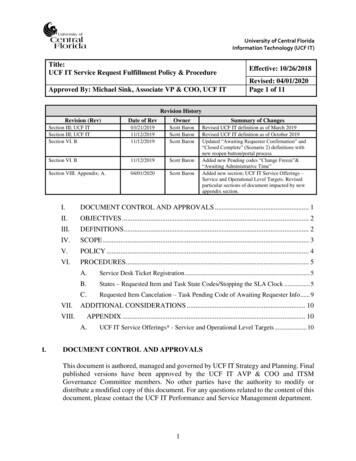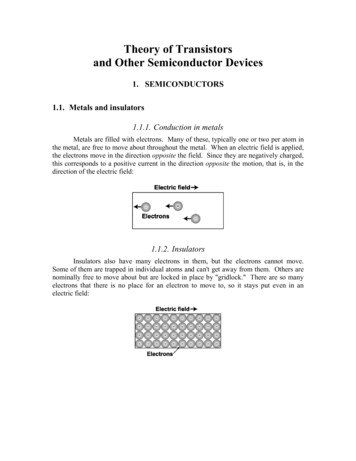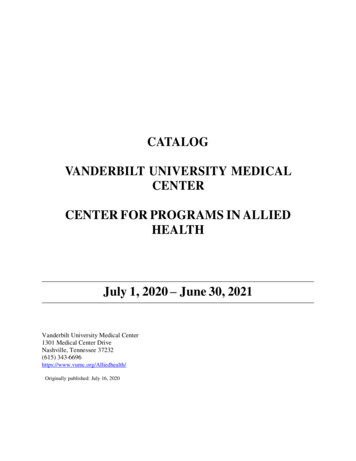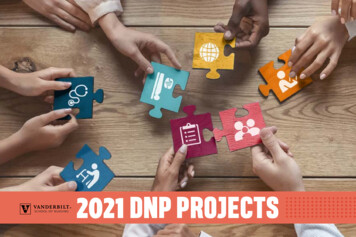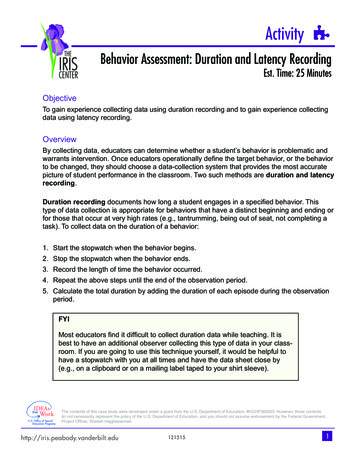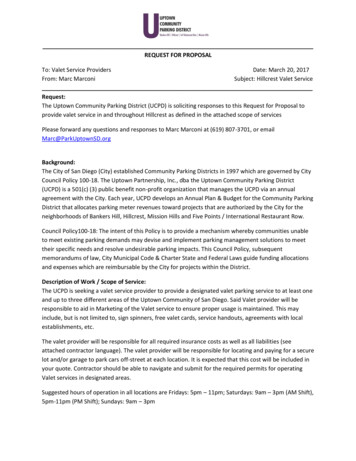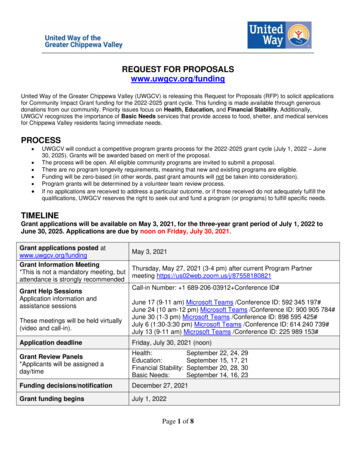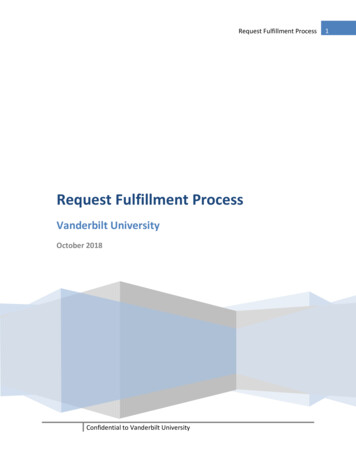
Transcription
Request Fulfillment ProcessRequest Fulfillment ProcessVanderbilt UniversityOctober 2018Confidential to Vanderbilt University1
Request Fulfillment ProcessCONTENTSVersion History. 3Introduction . 4Request Fulfillment & Service Catalog Concepts . 5Goals, Objectives & Scope . 6Goals . 6Objectives . 6Scope . 7Process Flow. 8Onboarding New or Updating Existing Request Catalog Item . 9Generic Request Fulfillment Process . 10Cancelling a Request . 11Roles & Responsiblities . 12Request Roles & Responsibilities. 12Requesters/Customers. 12First Level . 12Service Level Mangagement & Relationship Manager . 12Request Fulfillment Manager . 12Fulfillment Team (Second/Third Level Support) . 13Service Owner . 13Cherwell Administrator . 13Policies . 14Categorizing Requests. 16Request Status . 17Notification Triggers . 18Hierarchical Escalations . 19Priorities & Service Level Objectives. 20Impact, Urgency and Priority . 20Service Level Objectives . 20Key Performance Indicators. 21Confidential to Vanderbilt University2
Request Fulfillment ProcessVERSION /2018WhoReg Lo &Valerie ArrajITSM team,VUIT DirectorsGeorge AnglinGeorge AnglinGeorge AnglinCommentsFirst draftEdits, additionsCombine editsOverall edits and clarificationEditsConfidential to Vanderbilt University3
Request Fulfillment ProcessINTRODUCTIONThis document describes how to manage the Request Fulfillment process for VanderbiltUniversity IT (VUIT) and the Service Request Catalog in Cherwell. It is based on the InformationTechnology Infrastructure Technology Library (ITIL) and adapted to address VUIT’s specificrequirements.This document is divided into the following sections:SectionRequest Fulfillment &Service Request CatalogConceptsGoals, Objectives andScopeProcess FlowRoles & ResponsibilitiesPoliciesEscalationsKey ses the differences between Request Fulfillment, theRequest Catalog and the Service Catalog.Specifies the objectives of the Request Fulfillment process.Diagrams illustrating the high-level Request Fulfillmentprocesses including: Process to create / update a Catalog Item Generic process for submitting and fulfilling a RequestIdentifies the roles within the Request Fulfillment process andthe responsibilities for each role.Policies that support the Request Fulfillment process.Rules for email notifications that notify additional supportproviders.Specifies the metrics for measuring the success of the RequestFulfillment process.This document also outlines self-service capabilities and amechanism for segregating requests by university affiliation.Confidential to Vanderbilt University4
Request Fulfillment ProcessREQUEST FULFILLMENT & SERVICE CATALOG CONCEPTSThe Request Fulfillment process is responsible for managing the lifecycle of all Service Requestsin a standardized fashion. Service Requests are initiated by selecting an entry from list ofavailable standardized request items presented via a Service Request Catalog.The Service Request Catalog presents a list of requests for customers to browse. Requests andservices are different concepts. A service is generally delivered month after month – email is agood example. A request, on the other hand, is a transaction. A customer makes a request,there may (or may not be) an approval process, and IT (or some other service provider) fulfillsthe request. There is a definitive start and end date/time for a request.If we expand on the example of an email service, the most obvious request is “new emailaccount”. However, there may be other requests associated with the email service, e.g. “newemail distribution group” or “request a larger inbox”. Hence, a service may have one or morerequests.ServiceEmailRequestNew email accountNew email distributiongroupRequest larger InboxThis document focuses on requests.Within Cherwell Service Requests and Incidents are driven from the same module. The“Subcategory” field chosen on the Incident/Request form drives whether the record is treatedas an Incident or a Service Request.Confidential to Vanderbilt University5
Request Fulfillment ProcessGOALS, OBJECTIVES & SCOPEGOALSThe goals of the Request Fulfillment process are: To provide a channel for customers to request and receive standard services for which apre-defined approval and qualification process exists. To provide information to users and customers about the availability of services and theprocedure for obtaining them. To source and deliver the components of requested standard services (access, quotaincreases, new device). To assist with general information, complaints or comments.OBJECTIVESThe specific objectives of the Request Fulfillment process are:1. Provide the single easy-to-use portal for customers to submit requests.2. Facilitate and/or trigger the workflow for approval and fulfillment.3. Balance the ease-of-use for the request and fulfillment procedures with the desire tooptimize the cost for maintaining the catalog, e.g. provide a generic approach tofulfillment that can be leveraged by the majority of requests.4. Provide the mechanism and metrics for IT managers to manage their team’s fulfillmentactivities.5. Provide a standardized process for service owners (or their delegates) for submittingnew catalog items or updating existing catalog items, configuring, testing and deployingthe catalog items.Confidential to Vanderbilt University6
Request Fulfillment ProcessSCOPEAll Requests, whether they are customer-facing requests or internal IT-to-IT requests, are inscope. Where meant to be client-facing, the requests will be exposed to non-IT customers.The Request Fulfillment process owner will own:1. The generic fulfillment approach that can be applied to most requests.2. The process of creating new catalog items and updating existing catalog items.3. The process of creating new Specifics forms for teams to present to customers.Confidential to Vanderbilt University7
Request Fulfillment ProcessPROCESS FLOWThe process flow uses “swim-lane diagrams” to illustrate which role is responsible for theactivity. These roles are described in more detail in the following section titled “Roles andResponsibilities”.Confidential to Vanderbilt University8
Request Fulfillment ProcessONBOARDING NEW OR UPDATING EXISTING REQUEST CATALOG ITEMThis process is used by Service Owners (or their delegates) to request a new catalog item to beadded to the catalog or to request an update to an existing catalog item.Onboarding New or Updating Existing Request ItemService Owner(or Delegate)Request Process OwnerCherwell AdministratorRelationship Manager &Service Catalog OwnerStartNew requestitem or updatingan item?New request itemComplete/updaterequest itemspecificationExisting request itemRequest latestrequest itemspecification fromRequest FulfillmentManagerProvide latestrequest Request toRequestManagementConfigure servicerequest includingfulfillment workflowTest request item including fulfillment workflowNoTesting wassuccessful?Update request itemspecification asnecessaryStore request itemspecification in thespecificationrepositoryEndConfidential to Vanderbilt UniversityYesDeploy request itemto productionInform appropriateuser communities9
Request Fulfillment ProcessGENERIC REQUEST FULFILLMENT PROCESSThe generic Request Fulfillment process is designed to be used by the majority of servicerequest catalog items. The generic fulfillment process lets you associate a specific list offulfillment tasks with a catalog item that IT Fulfillment Team will execute when the item isrequested.Generic Request ProcessRequesterApproverCherwellFulfillment TeamAssign tasks basedon tasks associatedwith the requestComplete tasksStartSubmit requestApprovalrequired?YESApproved?NONOInform requesterthat request was notapprovedYESAll taskscompleted?Inform requesterthat request wasfulfilledNOEndConfidential to Vanderbilt UniversityNO10
Request Fulfillment ProcessCANCELLING A REQUESTCustomers may cancel a request if they no longer need the request item that they initiated.The process is depicted below.Cancelling a RequestRequesterCherwellFulfillment TeamCancel alloutstanding tasksNotify FulfillmentTeams ofCancellationStartSelect RequestRecord and ChooseCancel[cancel reasonrequired]NOConfirmationNotificationClose TicketEndConfidential to Vanderbilt University11
Request Fulfillment ProcessROLES & RESPONSIBLITIESREQUEST ROLES & RESPONSIBILITIESREQUESTERS/CUSTOMERS1. To request a service use the self-service portal or email or call the appropriate firstline team.2. Complete all fields as indicated.3. If it is an urgent request, customer should call to follow up with urgency.a. When submitting the request, please explain why this is urgent.4. Be available to answer questions about their request in a timely manner.FIRST LEVEL1. When recording a Request, choose the appropriate subcategory to obtain and completethe correct specifics form.SERVICE LEVEL MANGAGEMENT & RELATIONSHIP MANAGER1. Make customers aware of the existence of new request items.REQUEST FULFILLMENT MANAGER1. Reviews, evaluates and approves all requests to onboard new or modify existingRequest catalog Items.2. Ensures that all of IT follows the Request Management process.3. Ensures Service Owners are reviewing their request items yearly for relevancy andcurrency.4. Analyze request management metrics.5. Sponsor improvements to the process or tool(s).6. Informing Relationship Managers and Service Owners of new or changed requests.Confidential to Vanderbilt University12
Request Fulfillment ProcessFULFILLMENT TEAM (SECOND/THIRD LEVEL SUPPORT)1. Monitor their Request Item Task queue.2. Complete tasks within the specified timeframes.3. Track work Notes/Journal in the appropriate task.4. Update the status of the task in a timely manner.SERVICE OWNER1. Provide the specifications for the request item including the online request form(s) anda description of the approval and fulfillment workflows.a. Submit Requests to “onboard” a New service request that include:i. The Service, Service Category and Service subcategory values to link to.ii. Whether the service is client-accessible or not.iii. The approval team this needs to go to.iv. The fulfillment tasks and assignment teams and task rules (sequential orconcurrent) for each task.2. Whenever the Request needs to be updated, trigger the process by providing theappropriate catalog item specifications.3. Review their request items at least once a year to ensure they are up to date.4. Provide resources to test request items in Cherwell.CHERWELL ADMINISTRATOR1. Configures approved new or existing Service Request catalog items and fulfillmentworkflow.Confidential to Vanderbilt University13
Request Fulfillment ProcessPOLICIES1. Service Requests will be the official channel for making VUIT requests.2. Request items must be reviewed annually to ensure they are up-to-date and reflect currentfulfillment practices.3. All Requests must be recorded in Cherwell. The contact details of anyone with a VUNetIDwill be captured in the Customer fields. For all other customers contacting first linesupport, a Default Customer account will be used as a placeholder until customer is verified.4. If a customer is requesting service on behalf of another individual, the “Requested for”fields will be used to indicate the details of the individual who is the target of the servicebeing provided. First line support should indicate which individual(s) should receivecommunication as the request is being moved through the process to resolution.5. First and second line support will maintain a status indicator on the contact record inCherwell to signify that an individual is a VIP.6. If a customer emails, chats or calls a second or third level support analyst to initiate aRequest, the second or third level support analyst should encourage the customer to startat the appropriate first line support team.7. The urgent flag on an email does not affect the priority of an Incident. If the Request isurgent, customers must always follow up with a phone call.8. All fields must be completed in their entirety the person entering the request (first line orrequester/customer) so that the fulfillment teams have sufficient information to fulfill therequested item.9. Any significant work conducted on an Incident must be recorded in the work Notes/Journalof the Request/Task.10. A Request can only be put on-hold (taken off the Service Level Agreement clock) for thefollowing reasons: Waiting for customer On-Hold – Waitingfor Vendor Waiting for more information fromcustomer.Waiting for a supplierConfidential to Vanderbilt University14
Request Fulfillment Process On-Hold – ScheduledWork: On-Hold – PendingApproval Work has been scheduled, e.g.desktop technician will visitcustomer at an agreed date/time.Waiting for an approver action11. An interaction that was initiated as an Incident that should really be a Request must be“convertible” to a Service Request type record (ticket) in Cherwell.12. If a Requester/Customer cancels a Request the technician who owns the ticket will benotified and must close the request ticket.13. Attempt should be made to fulfill Request tasks within the specified due date according topriority.Confidential to Vanderbilt University15
Request Fulfillment ProcessCATEGORIZING REQUESTSRequests will be categorized per the Service, Category, and Subcategory scheme available inCherwell. Service Educause model “service offering” Category Component of the service offering Subcategory Drives ticket differentiation (Request vs Incident) Drives team auto-assignment Is more aligned with an “action”. In the case of Service Requests, each of theseactions will pull a correspondence “specifics” form that will ask specific questionsand collect the specific list of data elements required to successfully fulfill therequest.These values are service-dependent and are not listed in this document. However, thestructure for this construct is represented in the diagram below:Confidential to Vanderbilt University16
Request Fulfillment ProcessREQUEST STATUSSince Incidents and Requests are represented through the same form and record, constructs inCherwell the statuses are the same and are detailed below.1. New: Request is being created, recorded (initial details), classified, and assigned to ateam.2. Assigned: Request has been assigned to an owner.3. In Progress: Request is being investigated/fulfilled and resolved by an owner.4. Pending: Request is temporarily paused (Stop the SLA/O Clock).5. Resolved: Request has been resolved and is waiting to be closed.6. Closed: Request is closed.7. Reopened: Request is reopened because the issue was not fixed or reoccurred.The following shows the valid progression from one status to another. The leftmost columnshows current state value. The top row shows target state value. Where the intersection ofthe two is shaded light gray, the progression from current state to target state is valid andallowed. Where the intersection of the two is shaded dark gray, the progression from thecurrent state to the target state is not allowed. The progression to close is universally allowedas a mechanism for a requester/end user to “close” an Incident when it has resolved itself or ifthe customer has found a solution and remediation is no longer necessary.NewAssignedIn ProgressPendingResolvedNewAssignedIn ProgressPendingResolvedClosedReopenedConfidential to Vanderbilt UniversityClosedReopened17
Request Fulfillment ProcessNOTIFICATION TRIGGERSState changes will trigger an email notification as follows:StateRecipientNewCustomer – Inform that ticket has been createdand provide ticket number.Assigned (Request or task)Owner - Inform that ticket has been assigned tothem and provide ticket number. For urgentpriority, use xMatters to notify the team.In ProgressOwner - Remind him/her that the Request hasbeen inactive for three days.PendingOwner – Remind him/her to take action on theIncident at the end of the Pending period.ResolvedCustomer – Inform that request is fulfilled andcustomer has 3 days to respond that therequest has not been fulfilled to theirsatisfaction.ReopenedOwned By Team – Inform that ticket has beenreopened for further corrective action.ClosedCustomer - Customer Survey e-mail (rules TBD).Confidential to Vanderbilt University18
Request Fulfillment ProcessHIERARCHICAL ESCALATIONSHierarchical escalations are used when a Fulfillment Team does not or cannot respond orresolve within a defined timeframe for a specified priority of request. These notices aredelivered to team managers so they can manage work speed and communication to the enduser/customer or other key stakeholders as necessary.Time to respond is the time between the tic
SERVICE OWNER 1. Provide the specifications for the request item including the online request form(s) and a description of the approval and fulfillment workflows. a. Submit Requests to “onboard” a New service request that include: i. The Service,
